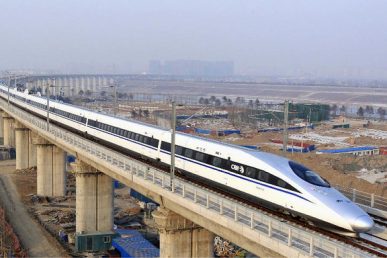For more stories from the fast track, attend OpenStack Days China in Beijing July 24-25.
Often the fastest track to virtualization and cloud computing for large state-owned enterprises is to build their own private clouds with open-source software.
Case in point: China’s Sinorail Information Cloud. This joint effort from Beijing Sinorail Information Engineering Group and Beijing T2Cloud was designed to serve the IT infrastructure for railway construction and related industries. The first phase of large-scale deployment of the private cloud product SRCloud OS/T2Cloud OS with OpenStack and other open-source software launched in early 2017. Beijing Sinorail Information Engineering Group is a subsidiary of China Railway Information Technology Center, providing IT services for railway and other industries. Cloud Tuteng, a well-known cloud platform product and service provider, is also a longstanding OpenStack proponent in China.
China’s massive railway system is a pillar of local industry: its tracks stretch some 124,000 km (77,000 miles) and it also boasts 20,000 km (12,500 miles) of high-speed rail lines, more than the rest of the world combined. New investment in railway continues apace at over 800 billion yuan per year, or $123.6 billion. Consequently, the IT architecture of railway faces an urgent need to be upgraded from the mainframes and minicomputers and centralized storage, blade servers and virtualization plus centralized storage to cloud computing. The high agility of cloud computing can quickly respond to launches and updates required by new initiatives and the high reliability of cloud computing ensures the smooth of operation of passenger and freight transportation.
Why did they get aboard OpenStack? Rao Wei, deputy general manager of Beijing Sinorail Information Engineering Group, says that when they were evaluating options, the ability to modify hardware and software and avoid vendor lock-in were key requirements. The team also found that OpenStack was a good way to go because of the development of the technology, the community and solid use cases.
Wei was aided on the journey by two excellent teams. To reach the four R&D goals of Sinorail Information Cloud product—stability, safety, flexibility and usability— T2Cloud and Beijing Sinorail Information Engineering Group made joint efforts to combine OpenStack modules, technology and ecology of Sinorail, automatic deployment, automatic detection and other tools and found an feasible way forward.
Tests proved that the OpenStack product developed jointly by the two teams obtained stable operations of 100,000 cloud hosts, 800 nodes in a single zone in the first phase of the project deployment. No one working on the project had never seen such a large volume of service deployment, the overall parallel I/O, pressure on storage, pressure on the network and bandwidth on any conventional platform.
In view of potential problems with the original OpenStack components, authentication system, memory interface, network interface, under-network DHCP service, forwarding service, the Sinorail project prepared well before deployment, including project preview, environmental pressure measurement and code repair, Wei says.
During the deployment process, the 800 physical nodes were deployed automatically through MagicStack and other automation tools developed by T2Cloud. The entire process took just one day. To ensure the stable operation of customer services, they also migrated a number of application services – such as Web services and file system services in the testing environment – and automatically deployed them, says Fan Weipeng, head of the Sinorail project.
When choosing a partner, Beijing Sinorail Information Engineering Group evaluated a number of domestic and foreign OpenStack vendors before going with T2Cloud. A deciding factor was the hands-on approach focused on helping customers truly grasp open-source technology and apply it independently in production, rather than simply acting as a go-between. In nearly two years of the joint R&D process, both sides invested heavily to reap stability and reliability.
The Sinorail project may offer a glimpse of where OpenStack is headed in China. It smoothed over what was viewed as the business predicament of OpenStack deployment and maintenance difficulties, explored the viability of creating an OpenStack product and demonstrated how vendors and users can work closely together. “We’re happy to share the experience and contribute to OpenStack,” concludes Wei adding that he hopes to have more R&D projects to join that will promote the domestic application of OpenStack while upholding the spirit of openness.
This post is a translation of an original article by Xiong Wei.
Cover Photo // CC BY NC
- Demystifying Confidential Containers with a Live Kata Containers Demo - July 13, 2023
- OpenInfra Summit Vancouver Recap: 50 things You Need to Know - June 16, 2023
- Congratulations to the 2023 Superuser Awards Winner: Bloomberg - June 13, 2023

)










